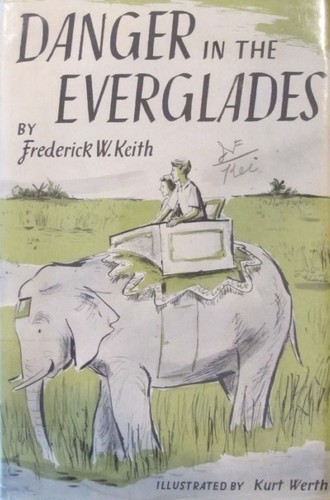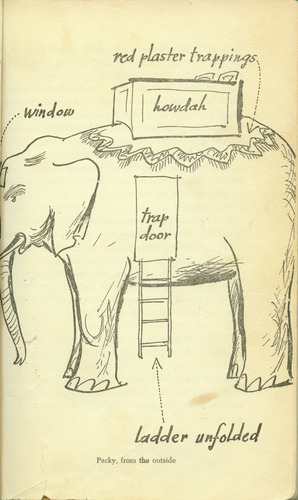
Danger in the Everglades.
Author: Frederick W Keith
Publisher: New York, Abelard-Schuman [1957]
[Thanks to Michael Rekoff who informed me about this book.]
Authors: Frederick W Keith
OCLC Number: 1420226
Description: 1 v. illus. 22 cm.
Responsibility: Illustrated by Kurt Werth.

A diagram of Packy's interior from page 17.

Packy's exterior, page 13.
Review from Amazon.com
Danger in the Everglades
3.0 out of 5 stars An odd premise for a "realistic" juvenile novel!, February 19, 2012
By Molly Grue "Renaissance Woman" (SF Bay Area, CA USA) – Danger in the Everglades
Steve Hubbard's parents and their boat, the Cormorant, disappear in a hurricane while heading for the Shark River in the southwestern tip of Florida, where his father had planned to fish while his mother collected wild orchids and other tropical plants. Eight days later, Steve anxiously waits for a positive word from the Coast Guard with his Aunt Ellie, who is taking care of Steve and his frail grandmother while his parents are away.
Steve is convinced that he can find his parents by travelling south in Packy (short for pachyderm—groan!), the wonderful electric elephant his father constructed. "It had two levers to steer it, like those on a tractor, a smaller gadget that you pushed forward and backward to control the speed, and some other thingamajigs that Steve knew how to handle. Then there was a one-cylinder gasoline engine stuck away next to the batteries to charge them." An electric elephant that relies on fossil fuel to recharge its batteries isn't truly electric—and Steve's dad must have been some sort of engineering genius, because the vehicle gets amazing mileage without being refueled!
Packy also contains three bunks, a lavatory and a small gasoline stove—yet there is no mention of a ventilation system, so how the occupants keep from suffocating or dying from carbon monoxide poisoning while the gas engine or stove are running is anybody's guess. The author similarly neglects to mention how the waste products from the lavatory are discharged.
Steve's dad "had built Packy just as a hobby" and then "had intended to rent [Packy] out for advertising purposes—to put a big sign on each side of it proclaiming somebody's product. But so far nothing had come of that and Mom refused to go traveling around in it so it had just stood in the garage." Okay then. An enormous project that consumes time, energy, money and garage space, and has yet to be taken on its maiden voyage. Got it.
"Its skin was genuine elephant hide, trunk and all. The hide was what had given his dad the idea of building it. He had read one morning in the paper that one of the largest elephants of the Ringling Brothers' Circus had died suddenly. An offer from him by telegram to buy its hide had been accepted. When the skin arrived in Daytona Beach by truck, Steve's dad had a local taxidermist cure and soften it thoroughly. Meanwhile he had gone ahead with the framework, and when the hide was ready he had slipped it over the wooden form." Is it just me, or is this a disgustingly creepy idea? And sheesh, you can't just build a framework and hope that a cured hide will magically fit!
The result? Packy looks exactly like a real elephant, albeit one with a glass windshield set in its forehead and "stitches along the belly where the taxidermist had sewn up the skin" and "Packy's eyes which Steve's dad had converted into headlights." And the two seat howdah on Packy's back and the over-the-tail red glass tailight, to prevent rear end collisions. And did I mention the "air horn in the base of the trunk that sounded only faintly like an elephant, but made up in volume for what it lacked in reality"? "The trap door, with a folding [aluminum] ladder fastened to it to get in and out by, could not be seen at all from the outside when it was shut tight."
This electric elephant is not only an engineering marvel, it's a transportation miracle! "It could walk through anything—swampy ground, underbrush, water (if it wasn't too deep) and even mangrove swamps…"
Now, let's pause a moment to ponder this carefully. A heavy machine made of organic materials (leather and wood) that concentrates all of its weight on four columnar appendages is perfect for navigating a swamp? I'd imagine it would get stuck in the mud, the leather and wood swollen and leaking absorbed moisture. Now, the author does mention that Steve's father carefully waterproofed the seams, and that Steve maintains Packy by oiling its numerous joints, but how that is accomplished (given the hide's closed seams) is left strictly to the reader's imagination.
Okay, elephant rant off.
So, Steve and Packy leave home with food, money, and a rifle, and instantly acquire two companions, Dave Graham and his sister Kitty, ages about fourteen and twelve. They are runaways from an orphanage in Redding run by cruel Mr. and Mrs. Edwards, and Steve twice helps the duo escape their abusive guardians before taking Packy away from civilization.
And then the story veers from science fiction to a rather pedestrian adventure about three young people and their journey through the Everglades, with a few lectures about the natural and political histories of the area (all delivered by characters in the book) thrown in for good measure. With a few caveats (noted below) it's not bad, just not terribly exciting, and the juxtaposition of this rather ordinary tale with the amazing electric elephant is rather bizarre.
The kids sit out a thunderstorm, explore an abandoned Seminole lodge, feed raccoon babies, and Steve shoots a rattler that's in Kitty's path. Then they head into town to buy groceries, and give money to a middle-aged Seminole, Tigertail Billy, who needs to pay for his shopping, but has lost his cash. The man invites the kids to come home with him, but they're headed in another direction, so they part company…until Packy gets stuck in the mud after fleeing a wildfire and the trio wind up near the reservation.
And bleargh, this is one of the spots where the book shows its age. When Tigertail rallies the tribe members to dig Packy out of the muck, David remarks, "Gosh, they've got on skirts, the big sissies," and Steve laughs. Tigertail's daughter is "pretty by Seminole standards" and when Tigertail's son Jumper eats with the kids, he suggests that his mother ladle out individual bowls for the three visitors ("although his mother could not see the point of it") while the rest of the tribe eats directly from the kettle. He then says, "I'll admit the white man's method of eating is more sanitary, but we Indians don't pay much attention to germs. And most of us live to a ripe old age just the same." These are just a few examples of the author's patronizing tone when describing the Native Americans.
The author's attitudes towards women are also dated, and while the sexism is relatively mild, it's noticeable. Once Kitty boards Packy, she automatically takes over the cooking and cleaning. Various males casually make disparaging remarks about females, and the females live up to these stereotypes…ugh. But I suppose these attitudes are not unexpected in a book this old.
Anyway, Jumper, Steve and Dave go frogging, Steve tumbles from the airboat and is rescued, and the three scare off an alligator poacher. The trio depart from the reservation on Packy and the boys manage to lose Kitty (who falls while washing Packy's tail light!) and find her again. They see a lot of wildlife and Steve gets stuck in quicksand and has to be rescued. They wander through a mangrove swamp, Packy nearly short-circuits in deep water, and they find Mr. and Mrs. Hubbard and rescue them. The Hubbards decide to adopt David and Kitty, and it's the end of the story!
The book contains seventeen illustrations, all rather crude. And my overall impression is…well, the story is memorable only because of the weird method of transportation. If the kids had been on horseback, this book would have sunk into obscurity. Is it worth reading? Only if you're dying of curiosity or brimming with nostalgia.
See real Mechanical Elephants in Florida, 1938 here.
Interesting to note that in 1950 the Frank Stuart Mechanical Elephant was undergoing developments to make it Amphibious. Sadly Stuart went bankrupt before completing his patent application so we'll never know what that next development would have looked like.
This book was one of my early introductions to Science Fiction. I also believe this Frederick W. Keith has depicted one of the first “Art Cars”. A popular sub-culture today is the art car world. There are many of these cars at the event called Burning Man. I’m sure some of those artists who build huge mechanical hippos and other animals might have been influenced by this book.
I came across this book when I was roughly 12 Y.O. (1958). Being mechanically inclined and a typical preteen of the day in terms of refinement, I recall enjoying this book that would hopefully reveal more “technical” details about Packy in later pages, which to my mild dismay did not happen. It was however a book that would creep back into my consciousness every now and then through the years. Thank you for enlightening those who may stumble onto this information. Your comments were interesting, but not much of that was evident or particularly important to this reader back in the day. Regards, John